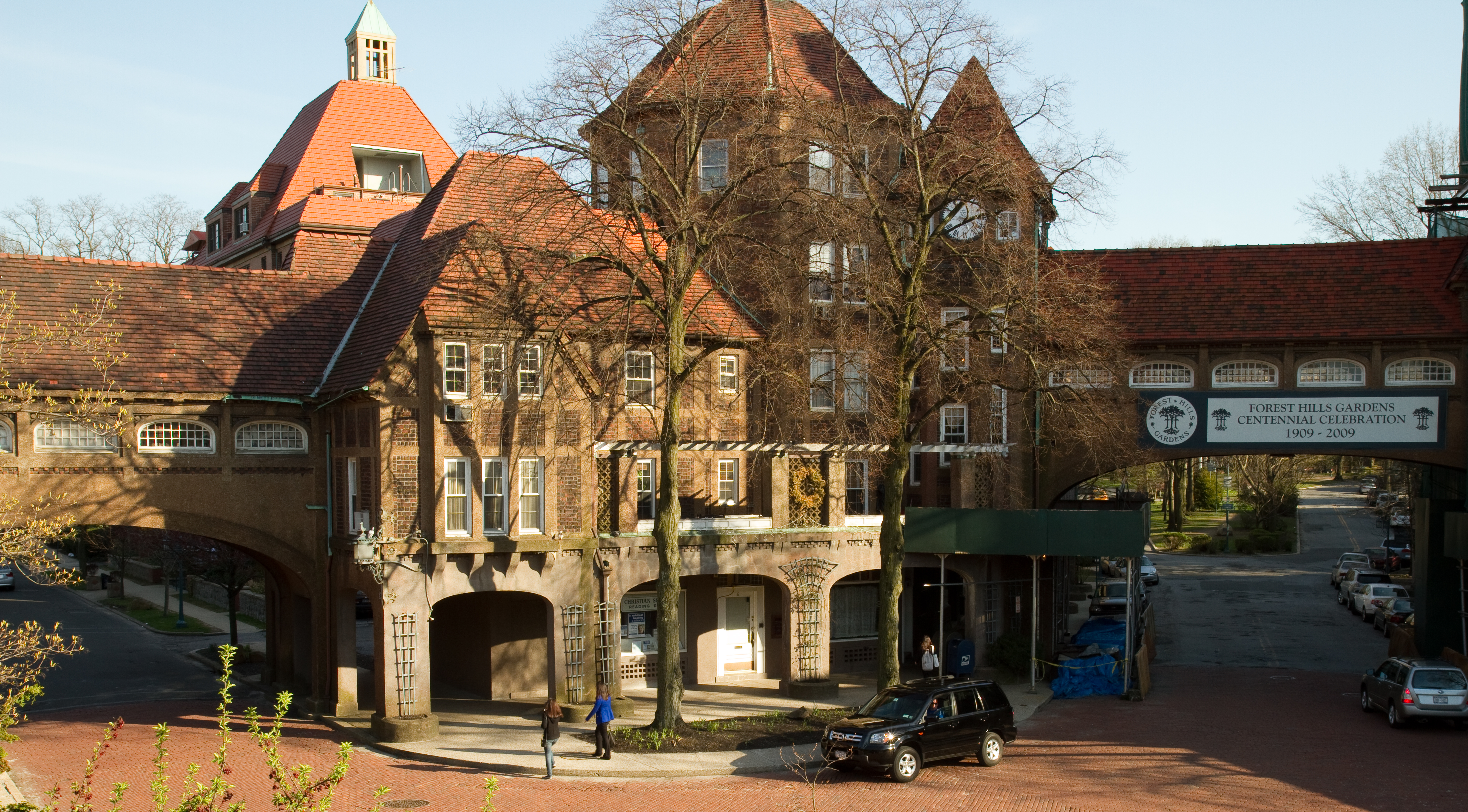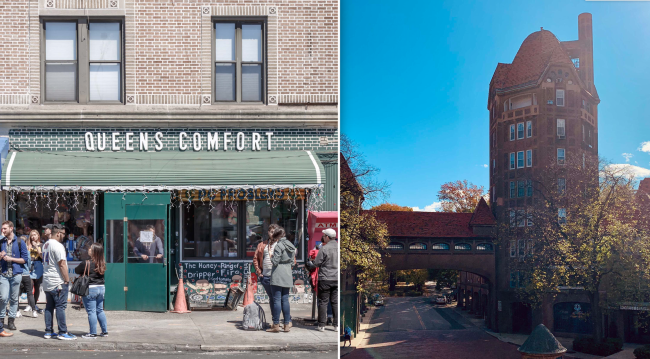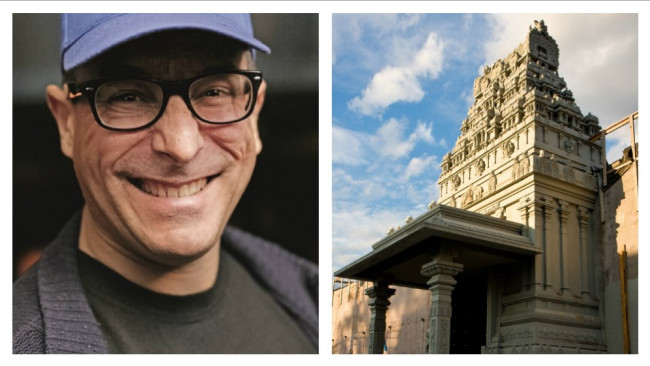Jackson Heights vs. Forest Hills: Which neighborhood is right for you?

Real estate in Jackson Heights is predominantly co-op buildings with private courtyards. Forest Hills has many Tudor-style rowhouses, especially in Forest Hills Gardens.
Garrett Ziegler/Flickr, left and Austin Havens-Bowen for Brick Underground/Flickr, right
Separated by one express subway stop, Jackson Heights and Forest Hills have similar median sales and rents, but that may be where the major similarities of these two Central Queens neighborhoods ends, because you’ll find very different vibes here.
Transportation is changing in both neighborhoods, which can have a broader impact beyond just how people get to work. In an effort to get more residents to use mass transit, Forest Hills commuters will soon be able to get discounted monthly passes for the Long Island Railroad. In Jackson Heights, the MTA is proposing a controversial major overhaul of the bus network as part of the Queens Bus Network Redesign, which would reroute buses like the Q32 and Q33 to go to the closest subway stations rather than the Roosevelt Avenue hub. Will these changes make life easier—and draw newcomers? Time will tell.
These changes are why Brick Underground decided to have the two neighborhoods face off. Other articles in our Neighborhood vs. Neighborhood series include Park Slope vs. Windsor Terrace, Kensington vs. Ditmas Park, Tribeca vs. Battery Park City, Washington Heights vs. Inwood, Astoria vs. Long Island City, and Astoria vs. Forest Hills.
So if you’re considering a move to Queens, read on to see what sets these two destinations apart, and if either matches your NYC lifestyle.

Forest Hills
Neighborhood boundaries: From 102nd Street to Grand Central Parkway from 62nd Avenue to 67th Avenue, then from Grand Central Parkway to Selfridge Street from 67th Avenue to Jackie Robinson Parkway.
Median sales price: $329,000
Median rent: $2,100
Living: Forest Hills offers laid-back and quiet surroundings, at least compared to Jackson Heights. It’s mostly residential with a handful of small parks and community gardens including Forest Park, the 10th largest park in the city. Tennis is a way of life in Forest Hills. The West Side Tennis Club moved from Manhattan to the Forest Hills Gardens back in 1914. Then came Forest Hills Stadium, which hosted the U.S. Open and other national championships through 1978. Today, The West Side Tennis Club still operates as one of the country’s most historic tennis clubs.
The development of Forest Hills began in 1906 when Cord Development Company purchased six farms. This was followed by Forest Hills Gardens, a private community, mostly constructed from 1910 to 1917. When the Long Island Railroad originally opened a station in Forest Hills, it joined the now-defunct Queens Boulevard trolley line, spurring growth of the neighborhood we know today.
Public schools include Forest Hills High School, and P.S. 101 The School in the Gardens, in a quintessential school building. There’s two Queens Public Library branches in Forest Hills. The neighborhood is served by Northwell Health’s Long Island Jewish Forest Hills hospital.
Housing: The housing stock in Forest Hills is diverse, with high-rise residential buildings, mostly along Queens Boulevard; and smaller five- and six-story prewar and post-war apartment buildings. Many of the apartments in the prewar buildings have large layouts. There’s also many Tudor-style townhouses and single- and two-family houses.
The best kept secret of the neighborhood is Forest Hills Gardens and its multi-million Tudor-style houses that recall an English suburb. It was the first planned garden community in the country and was inspired by the garden city movement in England at the turn of the century.
Eating and shopping: Jackson Heights has many shopping and dining areas, but Forest Hills’s main commercial area is on Austin Street, where you can find a mix of chain restaurants like T.G.I. Fridays, Shake Shack, and Chipotle mixed with local eateries like El Coyote and 5 Burro Cafe for Mexican fare; Reef for seafood; and MoCA Asian Bistro. Local bars include Station House; Austin Public; Jack & Nellie’s; and popular gastropub Queens Bully is a bit farther down on Queens Boulevard where you can catch live music, happy hours, and weekend brunch.
Shopping in the neighborhood is mainly concentrated on Austin Street, where you can find many factory outlet stores for brands like Gap, Banana Republic, Ann Taylor, and Eddie Bauer. There’s also many locally-owned shops like DMITRY Ties, Bagriculture, and Mr. Vino’s Cucina—plus there’s a Housing Works Thrift Shop.
Transportation: Forest Hills is served by the M, R, E, and F lines, all at the Forest Hills/71st Avenue station. There’s a Long Island Railroad station at Continental Avenue and Austin Street, and while the majority of Forest Hills residents take the subway, residents can also take the Long Island Railroad. Bus service includes the Q23, Q60, Q64, QM4, QM11, QM12, and QM18.
Area gems: The neighborhood’s green spaces include Macdonald Park along Queens Boulevard, where you will find art installations from various local artists and plenty of benches to relax on; the sprawling planned community of Forest Hills Gardens (keep in mind the parks there are private); and just outside of the neighborhood’s boundaries is Forest Park, the third-largest park in the borough where QueensWay, a Highline-esque park on abandoned train tracks, is set for development.
The vibe: The area is very family friendly—you’ll see lots of young couples pushing strollers down Austin Street and going to the park or the year-round farmers market on Sundays. Living solo? You will find you can get more space for your money than in other parts of the city.
Celebrities: Actor Billy Eichner of “Billy on the Street” fame was born and raised in the neighborhood, and Awkwafina, who is currently starring in “Nora From Queens,” grew up here.

Jackson Heights
Neighborhood boundaries: From the Brooklyn Queens Expressway to Junction Boulevard and 94th Street, then from Roosevelt Avenue to Grand Central Parkway.
Median sales price: $315,000
Median rent: $1,800
Living: Jackson Heights is busier and more commercial than Forest Hills, but you can find pockets of quiet, residential blocks. There’s several small parks around the neighborhood, like Travers Park between 34th Avenue and Northern Boulevard, which has a playground, basketball courts, benches, and chess tables.
The neighborhood was developed starting in 1911, when a series of 24 row houses were built, as part of the country’s first garden and co-op apartment community, and also its largest. Today, the neighborhood retains that charm, especially in the Historic District, which spans from 93rd to 69th Street between Northern Boulevard and Roosevelt Avenue.
Public schools include P.S. 69Q, which earned an A- from Niche. Jackson Heights has a Queens Public Library location on 81st Street.
Jackson Heights is considered one of the most diverse neighborhoods in the country (with sub neighborhoods Little Colombia and Little India). There are over 160 languages spoken here and lots of culinary options.
There’s also a thriving LGBTQ+ community, which is celebrated every year at the Queens Pride Parade and all year-round at the many popular gay bars, including Friend's Tavern, the borough’s oldest active gay bar and historic landmark.
Housing: Jackson Heights’s housing stock mainly consists of prewar co-ops, many have private courtyards and gardens, dating back to the original planned co-op community. There are a few condo buildings in the neighborhood mixed in with some rowhouses and semi-detached Tudor-style houses.
Eating and shopping: Jackson Heights is known for offering cuisines from around the world, such as Colombian, Indian, Tibetan, and Nepalese dining options. Some of the popular spots along Roosevelt Avenue include Nepali Bhanchha Ghar for authentic Nepalian food that’s been reviewed by the New York Times, Arpea Lady and Pollos a la Brasa Mario for Colombian fare, and The Queensboro, where you can enjoy Happy Hour during the week and brunch on the weekends.
Shopping is mainly concentrated along Junction Boulevard from 37th Avenue to 72nd Street and along Roosevelt Avenue. Local shops include Lockwood, a boutique selling everything from greeting cards to kitschy home accessories and Frank’s Pharmacy, a family-owned pharmacy that’s operated for a quarter-century. And there’s Patel Brothers, a popular Indian supermarket, and there’s lots of discount stores in the neighborhood.
Transportation: Jackson Heights is served by the 7 train along Roosevelt Avenue and you can catch the E, F, M, and R at the Roosevelt Avenue-Jackson Heights station. Buses include the Q32, Q33, Q47, Q49, and the Q53, Q70 Select Bus Service. You can get to LaGuardia Airport in 20 minutes on the Q33.
Area gems: The neighborhood’s street food scene is unlike anywhere else with a mix of traditional food carts, food trucks, and even makeshift grills in shopping carts along Roosevelt Avenue, serving up foods from around the world like arepas, tacos, churros, and more.
The vibe: The neighborhood’s thriving restaurants and nightlife gives the area along Roosevelt Avenue an electric feel any day of the week, while residential blocks are naturally quieter.
Celebrities: Howard Stern was born in the neighborhood, and his family moved a year later. Alfred Mosher Butts, co-creator of Scrabble, lived in Jackson Heights and there’s a street sign paying homage to the game at 35th Avenue and 81st Street.
You Might Also Like



























